- This topic has 11 replies, 4 voices, and was last updated 10 years ago by
 Bill Ward.
Bill Ward.
-
AuthorPosts
-
14 October 2015 at 2:23 pm #573491
 Bill WardParticipant
Bill WardParticipantHi,
In August 2013 I recorded an extremely unusual event during the Perseids.
One of my videos seemed to show a single video frame that had two distinct spectra. This turned out not to be so revolutionary after all but such events are quite rare and this was probably the first time it had been caught by video methods. (This is subject of a forthcoming short paper in the journal)
Just the other night I caught another remarkable event. Not as bright as the Perseid but just as interesting.
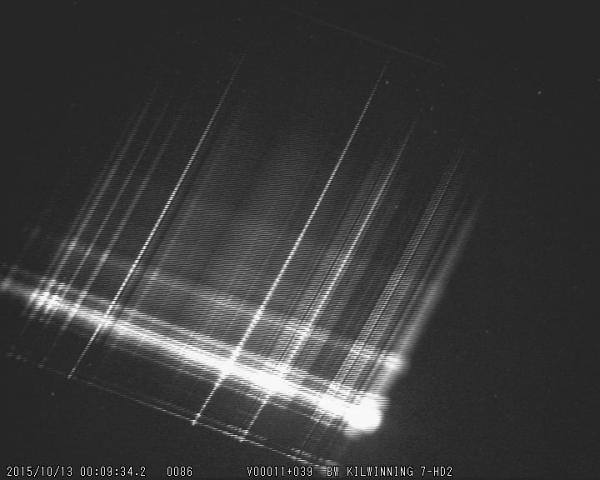
This was almost perfectly dispersed (for a change!). Some issues are immediately apparent. The blurry lines to the right side show the VERY rapid defocus of the optics in the deep blue/near UV. The lines from ~420nm to ~780nm are well focused then the much slower defocus can be seen on the set of atmospheric lines at the far left.
Whilst this is probably the best video spectrum I’ve secured in years it doesn’t tell the whole story. The meteor was travelling from top to bottom and the brighter areas are where the meteor flared. These composite images are fantastic and are what basically makes video meteor observing so useful. From normal videos light curves can be measured and with a grating the spectrum is sometimes beautifully seen. BUT sometimes it pays to take a closer look! Using the “de-interlace” feature of the ufo software all of the individual video frames can be examined. This is what revealed the first event on the Perseid fireball. This time I didn’t catch the event mid video frame, rather just in normal sequence.
This image is taken from the flare region. Immediately two spectra can be seen. The upper is the spectrum of the meteor and flare, the lower is the surviving fragment as it continues on its way.
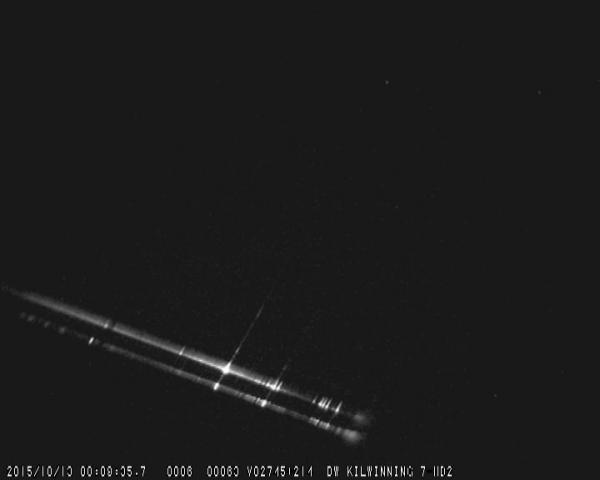
There are several distinct differences. Why, in the upper flare section don’t there seem to be any atmospheric lines (the group on the far left)? I would have thought it would have been the other way round, big flare lot of energy, temp at a max, this is where everything would be glowing but clearly not. There are another couple of lines which are the reverse case. They are emitting in the flare but not in the continuing meteor fragment. Intruiging.
Anyway, here are the non instrument corrected graphs of the two sections. These versions show the differences better I think.
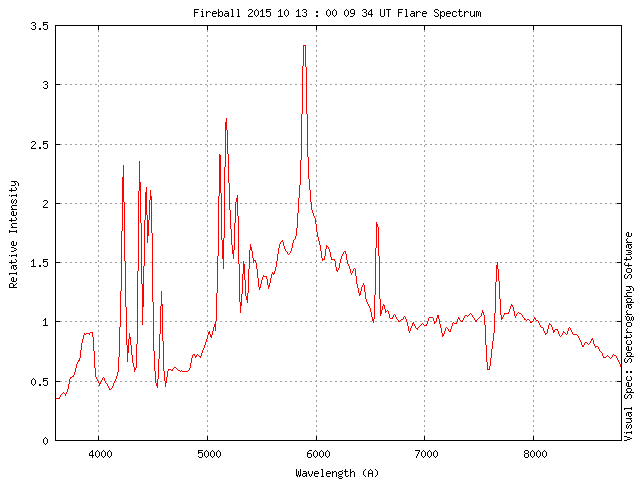
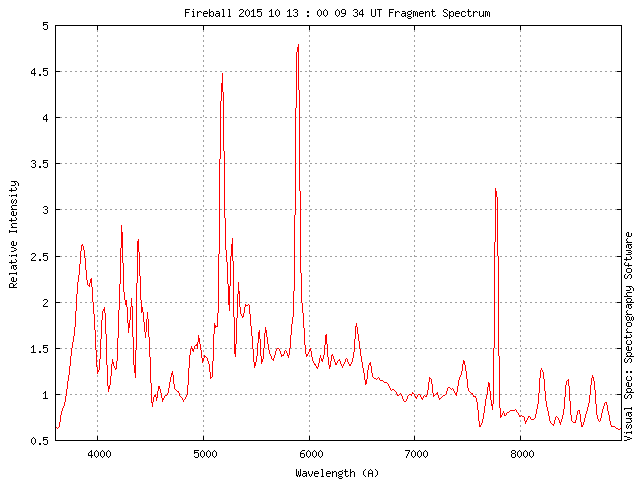
There is a movie at https://www.youtube.com/watch?v=F0dnyyQzUfs
Note: The spectrum shown in the video is an instrument corrected version but taken from approximately half way along the middle of the meteor trail where it was more uniform.
Utterly fascinating!
cheers,
Bill.
15 October 2015 at 9:11 pm #577107 Andy WilsonKeymaster
Andy WilsonKeymasterHi Bill,
Great spectra! Quite a catch to get everything to line up so well for the fireball. Interesting to see the differences in the flare, though I too do not know the reason for the difference.
Best wishes,
Andy
15 October 2015 at 10:43 pm #577109 Steve CuthbertParticipant
Steve CuthbertParticipantVery interesting Bill, can`t be easy catching a spectrum from a moving object!. Are you using StarAnalyser 100 in front of your video camera?.
Steve
18 October 2015 at 12:14 am #577111 Bill WardParticipant
Bill WardParticipantHi,
Andy, There was a lot of work done by the pros during the Leonid storms. There were several examples of this kind of behaviour caught but on CCD, not on video as far as I know. The experts like Borovicka and Jenniskens have written many scientific papers about this sort of thing. There are a lot of theoretical issues that need to be considered and I don’t fully understand all of it. I just don’t have the experience of “modelling” they do!
Steve, No it’s not a star analyser but still a grating just with more grooves in it. The one used in this case has 600 grooves/mm and is 50mm square (I think the star analyser has 100 or 200 grooves/mm). If you’ve got one and you’re interested in trying meteor spectroscopy then a star analyser can be used but it can only produce low resolution spectra.
cheers,
Bill.
19 October 2015 at 11:15 pm #577112 Bill WardParticipant
Bill WardParticipantHi,
Here’s a spectrum from the image taken just before the brightest flare.
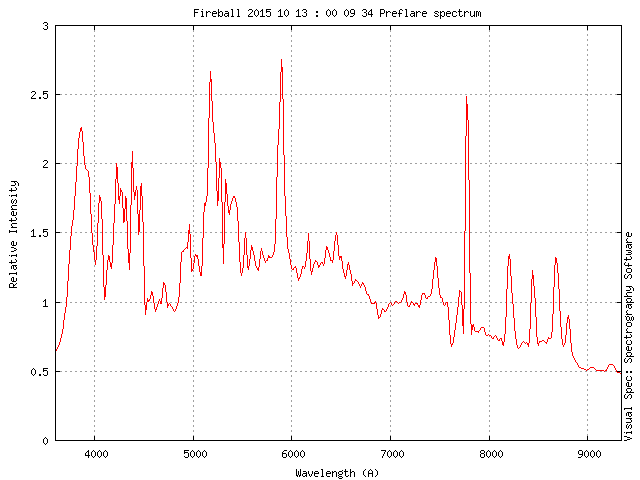
It’s almost the same as the “fragment” spectrum. Perhaps un-surprising, what goes in ends up coming out!. But it begs the question what happens during the flare to stimulate the other emissions. More digging required….
Anyway, it looks very nice…

cheers,
Bill.
20 October 2015 at 7:00 pm #577114 Robin LeadbeaterParticipant
Robin LeadbeaterParticipantNice catch Bill !
I am wondering if your fireball spectrum is actually of the cooling afterglow after the remnant had passed on rather than the fireball at maximum, which would explain the change in the spectrum and the lack of OI/NI lines in the IR. If you look at the previous frames in the video where the main flaring took place, most of the fireball spectrum is saturated but the OI lines can be seen carrying on straight through (see attached). This would be analagous to this fireball spectrum published earlier this year (recorded in 2012) for example
http://arxiv.org/ftp/arxiv/papers/1503/1503.06400.pdf
figs 2 and 3
Cheers
Robin
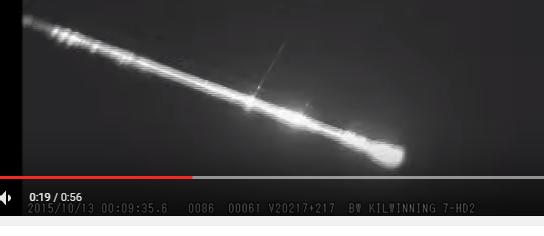
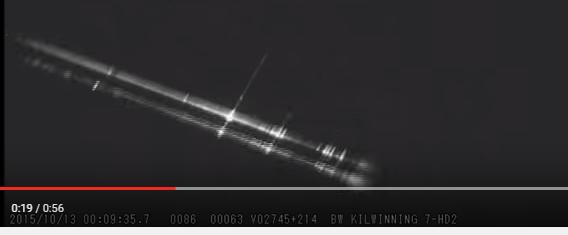 20 October 2015 at 9:18 pm #577115
20 October 2015 at 9:18 pm #577115 Robin LeadbeaterParticipant
Robin LeadbeaterParticipantHmm, one of the images does not seem to want to be displayed for some reason – trying again
 21 October 2015 at 2:40 pm #577117
21 October 2015 at 2:40 pm #577117 Bill WardParticipant
Bill WardParticipantHi Robin,
Thanks for your thoughts.
What you’ve described is pretty much what it is I think. The issue is with some of the remenant lines in the flare (the cooling section if I understand you) that are not atmospheric.
This isn’t a particulalry good graphic but if you look closely at the strong line at 777.4 nm, immediately to the left of it is another line. This can be seen if you examine the composite closely. (Purple is the flare section, blue is the weaker “gap” sepctrum and red is the fragment.)

This MAY be a triply ionised silicon line. In the only other case that I’ve recorded this type of behaviour, a Perseid fireball in 2013, this and other features were attributed by Jiri Borovicka as being deep blue lines overlapping from the next order. Jiri kindly provided a fully annotated graphic that I included in the Perseid short paper mentioned. Due to the quality of the Persied spectrum I couldn’t really argue (and of course it may very well have been completely different) but in this case I don’t think there is any doubt. Looking at the blue lines they suffer rapid de-focus and the same effect would be seen from the next order up. In this case the line is quite sharp so I believe it is a geniue emission at that wavelength. Also the other peaks in the purple line may be from silicon. Absolute identification is impossible, though due to the low resolution and that is the big problem!
There must be a short interval of time, of the order of a few milliseconds when the crushing pressure on the meteorid is a max and so probably is the temperature. This may momentarliy cause what might be called a “flash boiling” of the surface. The calculations are fraught with so many assupmtions that it’s impossible to say for sure what any given case is though. Clearly there is a fragment that exists for a few more milliseconds so it mast have had some material integrity. So what I think is being seen is emission from the cloud of meteoroid vapour generated at the max P and Max T if the meteoroid is tough enough to survive the whack it gets at this point. However if these lines are indeed silicon from the breakdown of SiO2 (silica/quartz) one of the peaks in the flare spectrum should (perhaps could ?) be O at 615.7nm and be of meteoroidal origin and not atmospheric.
I can’t lay my hands on it as I type but Jiri Borovika also wrote a paper in 1994 about a “twin temperature” model that could be used to explain particular emissions. I think these were in the region of 3000K and 10000K if memory serves. I’m afraid I just don’t know enough about the chemistry/physics/quantum mechanics to fully understand how it actually works. The best I can do is to read it as some “part” of the meteor is at one temp, maybe this is the hotter flash cloud. The another “part”, the surviving fragments, are at the lower temp due to whatever particular bulk thermal properties the meteoroid has.
We need more examples and better resolution!
Cheers,
Bill.
21 October 2015 at 4:38 pm #577118 Bill WardParticipant
Bill WardParticipantHi,
With the power of modern software it is possible to calculate all sorts of things. Thanks to the other observers of the NEMETODE group the orbit of this particular body has been determined. Using a couple of the orbital elements the meteoroids velocity can be calulated not only at the impact point with Earth but also at any point. However it’s interesting to compare the velocity at perihelion, ~64.1km/s and at aphelion, ~ 5.5km/s to the Earths own ~30km/s. From cruising out near Jupiter to whizzing along as it rounded the sun before it’s fateful encounter….
Bill.
22 October 2015 at 2:56 pm #577122 Bill WardParticipant
Bill WardParticipant…and some more number crunching that I’m not very sure about.
If the absolute magnitude and velocity as derived by UFO capture are roughly correct then this yields a mass of around 20g for the meteorid. This is with some of those assumptions I mentioned but it’s the correct “order of magnitude” as they say… 😉
25 October 2015 at 5:21 pm #577129 Bill WardParticipant
Bill WardParticipantAn interesting development that only spectroscopy can reveal an insight into…
(Or possibly throw a red herring!)
I received a tweet from another observer (JS) enquiring as to the possibility of this particular fireball being a Southern Taurid.
Initially I said no because the observations by the NEMETODE members had indicated a sporadic but the elements had some similarities. I remembered that last year around the same time I had caught another fireball that I was confident was a STA but didn’t have any orbital data.
I dug out the image and plotted the spectrum, then overlaid the spectrum of this years “sporadic”. Apart from some minor lines that may or may not be real, the bulk spectrum signatures are essentially identical! I found this to be both an impressive correlation and an intruiging result!
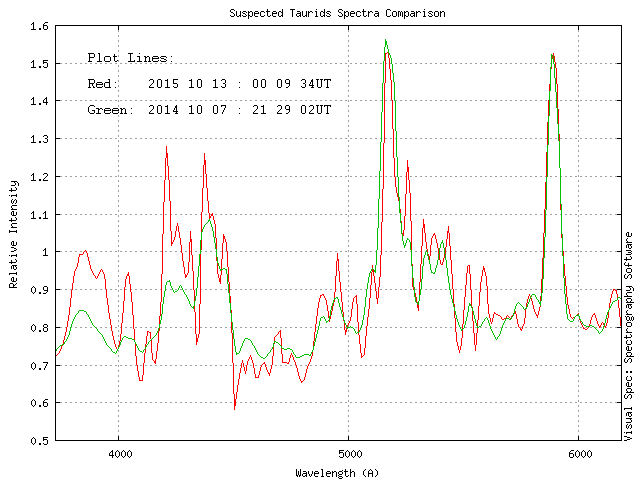
So what is the truth?, difficult to say but in the first instance the evidence point to the two meteoroids being made of the same stuff. JS had caught a still image with the fireball of this year and it certainly tracks back to the general region of the STA radiant despite not matching exactly (by UFO). Perhaps this one is a little bit of Comet Encke that’s been perturbed gravitationally (by Jupiter) or has been ejected with such a velocity that it has evolved into a slightly different orbit.
No matter, through spectroscopy, the evidence of the compositional similarity is very good.
Cheers,
Bill.
1 December 2015 at 10:07 pm #577163 Bill WardParticipant
Bill WardParticipantHi,
This particular spectrum continues to reveal remarkable subtleties…
From the two graphs of the flare and fragment the sodium lines looks very broad in the flare but doing another comparision with the synthetics I think this gives a really good impression of it’s “fuzziness” (thats a technical spectroscopy term 😉 )
However some of the lines in the flare spectrum seem to be a little sharper than the equivalent lines in the fragment. That is the other way round. I’m pretty sure this is some thermal broadening effect of the spectrum and is related to the particular atomic properties of the individual elements involved.
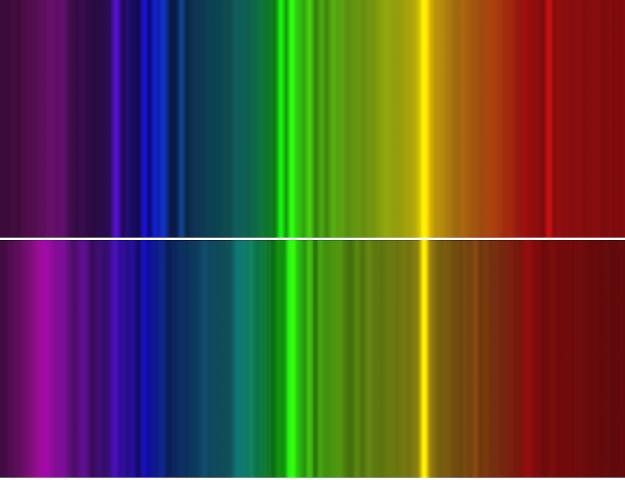
As mentioned in the previous posts’ the ubiquitous Jiri Borovicka wrote some research papers about “dual temperture” emissions. I’ve read this stuff several times and I’m still not completely clear on it. His 1993 (not ’94 as I said) paper on a fireball spectrum is pretty heavy duty. This involves looking at multiplet lines and their respective “curves of growth”. These can be used to imply temperatures and seems to come up with this, rather odd situation to me at least, of something being at two temperatures at the same time. But also as previous, the timescale between the maximum light, where I would have thought temps and pressure would be a max is separated from the cooling bit by only a few milliseconds. This looks very much a non equilibrium process. I’m beginning to think it’s more of an “energy” thing rather than temperature in the usual manner.
It’s all good….
cheers,
Bill.
-
AuthorPosts
- You must be logged in to reply to this topic.
